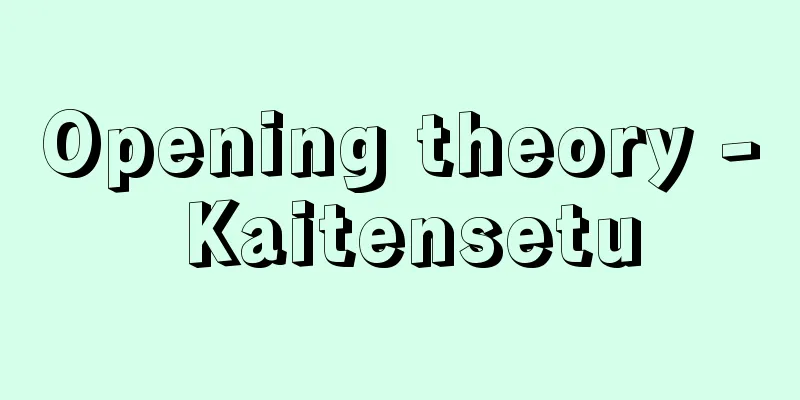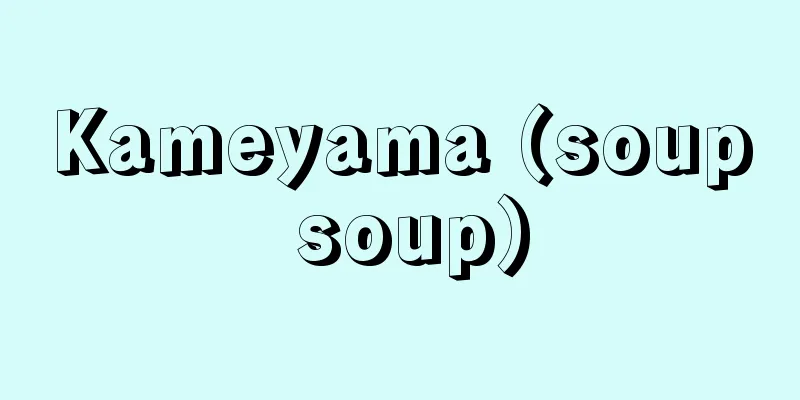Radio drama - rajiodorama

|
A drama program broadcast on the radio. Also called a radio drama. This term is Japanese-English, and in the West it is generally called radio play or audio play. When radio broadcasting first began in Japan, the terms "broadcast stage play" and "radio drama" were used in Tokyo, and "dialogue drama" in Osaka. The name originated from the emphasis on copying stage plays or dialogue, but the essence of radio drama is that it appeals to the listener's hearing by blending together the four elements of (1) voices, including real sounds (dialogue, narration, monologue, etc.), (2) music, (3) sound effects, and (4) silence. [Toriyama Hiroshi] Early radio dramasOn July 12, 1925 (Taisho 14), the first day of regular radio broadcasting, a radio drama was broadcast. It was "Kirihitoha" (the scene in Lady Yodo's bedroom) by Tsubouchi Shoyo, and featured Nakamura Utaemon V. The first step in radio drama was to gain social acceptance of this new form of expression. The first full-scale work was "In the Coal Mine" (1925), adapted and conducted by Osanai Kaoru from a British radio drama written by Richard Hughes. The work depicted the psychology of people trapped in a coal mine in the dark, and appealed strongly to the listener's hearing with sound effects such as the sound of water and explosions, music from a hymn choir, dialogue, and silence. In 1927 (Showa 2), 12 established writers, including Kikuchi Kan, Satomi Ton, and Kishida Kunio, were asked to write in order to pioneer a new field, and the following year, an attempt was made to discover new writers by holding a prize competition. These attempts bore fruit in the 1930s. Mafune Yutaka discovered the rhythm of sound in works such as "Nadarake" (1935). Morimoto Kaoru approached the literary world of sound through fresh words (dialogue) in works such as "Rose" (1936). Meanwhile, budding writers such as Ima Uhei (Ima Harube) and Iizawa Tadasu were also active. Meanwhile, in 1937, the genre of "radio novels" was born, and works such as Natsume Soseki's "Sanshiro" and Nagatsuka Takashi's "Tsuchi" were featured. Until the end of World War II in 1945, broadcasting in Japan was monopolized by the Japan Broadcasting Corporation (NHK). [Toriyama Hiroshi] Radio drama in its heydayThe heyday of radio dramas was from the chaotic period after World War II until around 1960 (Showa 35), when television became widely available. Immediately after the war, radio broadcasting was restarted under the guidance of the Civil Information and Educational Service (CIE). The Japanese version of the soap opera (series) that was a hit in the United States at the time, "The Three Houses Across the Streets" (NHK, 1947-53), was established as a serial home drama. Among the serials, the one that became a hot topic was "The Hill Where the Bells Ring" (NHK, 1947-50) by Kazuo Kikuta, whose story of a war orphan touched the hearts of people who were devastated by the defeat. Serials such as "With Eriko" (NHK, 1949-52) by Naoya Uchimura and "Your Name" (NHK, 1952-54) by Kazuo Kikuta achieved high listener ratings. Meanwhile, one-off radio dramas were attempted in programs such as "NHK Radio Little Theatre" (1948-54). In 1951, private broadcasting stations such as New Japan Broadcasting (now MBS), Radio Tokyo (now TBS), and Chubu Nippon Broadcasting began operations one after another, and radio dramas became an important genre. Some of the masterpieces that have been produced include Yoko Tai's "Gyomon" (NHK, 1948), Tadashi Iizawa's "Sukiyabashi no Shinkiro" (NHK, 1949), Junji Kinoshita's "In the East" (NHK, 1954), Kobo Abe's "The Man Who Became a Stick" (Nippon Cultural Broadcasting, 1957), Shuntaro Tanikawa's "Distant Guitar, Distant Face" (Radio Kyushu, 1958), and Matsushiro Akimoto's "Hitachibo Kaison" (Asahi Broadcasting, 1960). In 1953, when regular television broadcasting began, NHK Radio attempted a three-dimensional radio drama with Uchimura Naoya's "Dead Chicken." In 1956, NHK aired a translation of British poet Dylan Thomas's "Under Milkwood" (BBC, 1954), which influenced subsequent radio verse dramas such as Miyoshi Juro's "Sutekichi" (1958). [Toriyama Hiroshi] Radio dramas from the TV eraAdvertising expenditures for commercial radio broadcasting peaked in 1960 and have been declining ever since. Under adverse conditions such as being pushed out by television, reduced listening time, and cuts in production costs, radio programs have become more oriented toward live information and lifestyle information, while radio dramas have chosen to focus on a small number of programs. In this environment, Terayama Shuji developed his own unique world in works such as Yamauba (NHK, 1964), which won the Prix Italia Award, and Ookami Shounen (Aomori Broadcasting, 1968). In addition, Tokai no Futatsu no Kao (The Two Faces of the City, 1963) was a unique work that depicted the momentary sparkle of life, depicting the story of a young man and woman's meeting and parting through a series of real sounds and some music. In 1965, NHK's "FM Masterpiece Theatre" began, re-broadcasting classic and popular works from the past. With the rise of live lifestyle information programs, there was concern that they would become overwhelmed by the everyday, and attempts were made to break away from the stale style of these programs by programming long-form specials and reviving radio dramas. In 1978, the first hour-long drama series on commercial broadcasting, "Watashi no Bunkohon" (Cultural Broadcasting), was released, followed by "Yoru no Drama House" (Nippon Broadcasting System) and "Yoru no Mystery" (TBS). In 1980, the two-hour literary drama "Kumaarashi" (Bear Storm) (TBS), based on a novel by Yoshimura Akira, was released, and in 1981 "Naze ni sunk by the Toya Maru" (TBS) became a hot topic. In 1986, the once popular serial drama "Ukkari fujin to chakkari fujin" (TBS) was revived. NHK's "FM Theater" (regular slot) has aired Takagi Rin's (1947- ) "Pipate Roma - The Island at the End of the South" (1997, Art Festival Excellence Award), Sannomiya Mayuko's "The Sky the Birds Taught Me" and Nishiyama Tsutomu's "Bicycle in May" (both 1998). Mainichi Broadcasting System also aired "Heart of Gold" (1998, based on Ogawa Tatsuo's "Golden Soul"), which follows a high school teacher who lost his wife in the Great Hanshin Earthquake as he challenges himself to a triathlon while carrying a prosthetic leg. Yokomitsu Akira (1930-2001) received the Minister of Education's Art Encouragement Prize in 1996 for "Harukanaru Zuriyama" and "Ai no Ghost '95". In our complex information society, radio broadcasts have established themselves as a source of everyday information that is closely tied to the local community. However, in today's world where there is an abundance of television dramas, the question of how to position radio dramas as a source of emotional information remains a problem for the future. [Toriyama Hiroshi] "Radio Drama" edited by Tsutomu Oshima and Hiroshi Toriyama (1973, Nippon Columbia)" ▽ "The Japan Commercial Broadcasters Association, edited and published "A Thirty-Year History of Commercial Broadcasting" (1981)" ▽ "The Japan Broadcast Writers Association, edited "Compilation of Contemporary Japanese Radio Dramas" (1989, Okisekisha)" [References] | | | | | | | | |Source: Shogakukan Encyclopedia Nipponica About Encyclopedia Nipponica Information | Legend |
|
ラジオで放送するドラマ番組。放送劇ともいう。この呼称は和製英語で、欧米では一般にラジオ・プレイradio play、オーディオ・プレイaudio playとよぶ。日本ではラジオの放送開始のころは、東京では「放送舞台劇」「ラジオ劇」、大阪では「科白(せりふ)劇」という用語をあてていた。命名は舞台劇の引き写し、あるいは台詞(せりふ)重視から始まったが、ラジオドラマの本質は、(1)現実音を含む声(台詞、ナレーション、独白など)、(2)音楽、(3)効果音、(4)沈黙、の4要素を渾然(こんぜん)一体として聴く人の聴覚に訴える点にある。 [鳥山 拡] 草創期のラジオドラマ1925年(大正14)7月12日、ラジオ本放送開始第1日に「ラジオ劇」が放送された。坪内逍遙(しょうよう)作『桐一葉(きりひとは)』(淀君(よどぎみ)寝所の場)で、出演は5世中村歌右衛門(うたえもん)であった。ラジオドラマの第一歩は、まずこの新形式の表現を社会的に認めさせる点にあった。本格的な最初の作品は、リチャード・ヒューズ作のイギリスのラジオドラマを小山内薫(おさないかおる)が翻案・指揮した『炭坑の中』(1925)であった。炭坑に閉じ込められた人間心理を暗闇(くらやみ)のなかで描いた作品で、水音や爆発音などの効果音、賛美歌合唱の音楽、台詞、沈黙など、聴く人の聴覚に強く訴えるものであった。27年(昭和2)、菊池寛(かん)、里見弴(とん)、岸田国士(くにお)ほかの既成作家12人に新分野開拓の目的で執筆が依頼され、翌年には懸賞募集による新人作家発掘が図られた。こうした試みは1930年代に入ると実を結ぶ。真船豊(まふねゆたか)は『なだれ』(1935)などで音のリズムを発見する。森本薫は『薔薇(ばら)』(1936)などで新鮮なことば(台詞)により音の文学世界に接近する。一方、伊馬鵜平(いまうへい)(伊馬春部(はるべ))、飯沢匡(ただす)などの新進作家も活躍した。一方、37年には「ラジオ小説」のジャンルが誕生し、夏目漱石(そうせき)の『三四郎』、長塚節(たかし)の『土』などが取り上げられた。45年の第二次世界大戦終戦まで、日本の放送は日本放送協会(NHK)による独占体制であった。 [鳥山 拡] 隆盛期のラジオドラマ第二次世界大戦後の混乱期からテレビの本格的普及の1960年(昭和35)ごろまでがラジオドラマの隆盛期である。終戦直後、ラジオ放送はアメリカ民間情報教育局(CIE)の指導下に再出発した。当時アメリカでヒットしていたソープ・オペラ(連続もの)の日本版『向う三軒両隣り』(NHK、1947~53)が連続ホームドラマとして成立した。連続もののなかで話題となったのは菊田一夫(かずお)の『鐘の鳴る丘』(NHK、1947~50)で、この戦争孤児の物語は敗戦で虚脱状態になった人々の心を打った。内村直也(なおや)の『えり子と共に』(NHK、1949~52)、菊田一夫の『君の名は』(NHK、1952~54)などの連続放送劇は高い聴取率をあげた。一方、単発ラジオドラマは「NHKラジオ小劇場」(1948~54)などで試みられた。51年、新日本放送(現MBS)、ラジオ東京(現TBS)、中部日本放送などの民間放送が続々と開局、ラジオドラマは重要なジャンルとなっていった。田井洋子の『魚紋(ぎょもん)』(NHK、1948)、飯沢匡の『数寄屋橋(すきやばし)の蜃気楼(しんきろう)』(NHK、1949)、木下(きのした)順二の『東の国にて』(NHK、1954)、安部公房(あべこうぼう)の『棒になった男』(文化放送、1957)、谷川俊太郎(しゅんたろう)の『遠いギター、遠い顔』(ラジオ九州、1958)、秋元松代の『常陸坊海尊(ひたちぼうかいそん)』(朝日放送、1960)などの名作があげられる。テレビ本放送開始の53年、NHKラジオで内村直也の『死んだ鶏(にわとり)』が「立体放送劇」として試みられた。また、56年イギリスの詩人ディラン・トマスの『ミルクウッドの下で』(BBC、1954)がNHKで翻訳放送され、三好(みよし)十郎の『捨吉(すてきち)』(1958)などその後のラジオドラマの詩劇に影響を与えた。 [鳥山 拡] テレビ時代のラジオドラマ民間ラジオ放送の広告費は1960年のピークを境にして下降をたどった。テレビに押され、聴取時間の減少、製作費の削減などの悪条件のもとで、ラジオ番組は生(なま)情報・生活情報志向が強化され、ラジオドラマは少数志向の道を選んでいった。そのなかで、寺山修司(しゅうじ)はイタリア賞受賞の『山姥(やまうば)』(NHK、1964)、『狼(おおかみ)少年』(青森放送、1968)などで独自の世界を展開した。また『都会の二つの顔』(NHK、1963)は、若い男女の出会いから別れまでを現実音の積み重ねと若干の音楽で構成し、一瞬の生のきらめきを表現した異色作であった。65年には、NHK「FM名作劇場」が始まり、往年の名作・話題作が再現・放送された。 生ワイド生活情報番組の興隆のなかで、日常性への埋没を危惧(きぐ)し、その手法のマンネリ化からの脱皮を図って、長時間のスペシャル編成とラジオドラマの復権への試みが続けられた。1978年に、民間放送では初めての1時間ドラマシリーズの『わたしの文庫本』(文化放送)が登場、ほかに『夜のドラマハウス』(ニッポン放送)、『夜のミステリー』(TBS)などが編成された。80年には2時間の文芸ドラマ、吉村昭(あきら)原作の『羆嵐(くまあらし)』(TBS)が、81年には『洞爺(とうや)丸はなぜ沈んだか』(TBS)などが話題となった。86年には、かつての人気連続ドラマ『ウッカリ夫人とチャッカリ夫人』(TBS)が復活した。NHKの「FMシアター」(レギュラー枠)では、高木凛(りん)(1947― )の『パイパテローマ――南の果ての島』(1997、芸術祭優秀作品賞)、三宮麻由子(さんのみやまゆこ)原作の『鳥が教えてくれた空』、西山務原作の『五月の自転車』(ともに1998)などが放送された。また毎日放送では、阪神大震災で妻を失った高校教師が義足のハンディを背負いながらトライアスロンに挑戦する姿を追った『ハートオブゴールド』(1998・原作は小川竜生(たつお)の『黄金の魂』)が放送された。なお、横光晃(よこみつあきら)(1930―2001)は96年に『遙(はる)かなるズリ山』『愛のゴースト'95』で芸術選奨文部大臣賞を受賞した。 錯綜(さくそう)する情報化社会のなかでラジオ放送は地域社会に密着した生活生情報源として定着したが、今日のテレビドラマの氾濫(はんらん)のなかで、ラジオドラマをどのように心の情報源として位置づけるかは今後の問題として残されている。 [鳥山 拡] 『大島勉・鳥山拡監修『ラジオ・ドラマ』(1973・日本コロムビア)』▽『日本民間放送連盟編・刊『民間放送三十年史』(1981)』▽『日本放送作家協会編『現代日本ラジオドラマ集成』(1989・沖積舎)』 [参照項目] | | | | | | | | | |出典 小学館 日本大百科全書(ニッポニカ)日本大百科全書(ニッポニカ)について 情報 | 凡例 |
<<: Radical reaction - Radical reaction
>>: Radio calisthenics - Rajio taiso
Recommend
Latitude of the horse - Umanoido
This is a translation of the English "horse ...
Kamioka mine
This non-ferrous metal mine was located in the Ka...
Shori
A person who cooperates with government politics ...
Massachusetts [State] - Massachusetts
A state in New England, USA. Abbreviated as Mass. ...
Pros Hebraious; Letter to the Hebrews
A book in the New Testament. Many authors have bee...
Clothing Order - Ifukurei
…This system was adopted not only by China but by...
Balde, T.
…In these advanced countries, national unificatio...
Parennin, D.
…This is a book on European anatomy that was tran...
Seeliger, Hugo von
Born: September 23, 1849 in Biala, Silesia Died De...
Kashimo [village] - Kashimo
A village in Ena County, on the eastern edge of Gi...
Hachiman Festival Komochizuki Lively - Hachiman Festival Yomiya Lively
A Kabuki play. A domestic drama in four acts. Wri...
Aymara - Aimaara (English spelling)
An indigenous group living in Peru and Bolivia in...
Okyozuka ruins - Okyozukaiseki
This is a settlement site from the late to final J...
Casuarius casuarius (English spelling) Casuariuscasuarius
...It is said that the first live birds were impo...
Book lift
...In order to provide services to the entire reg...









